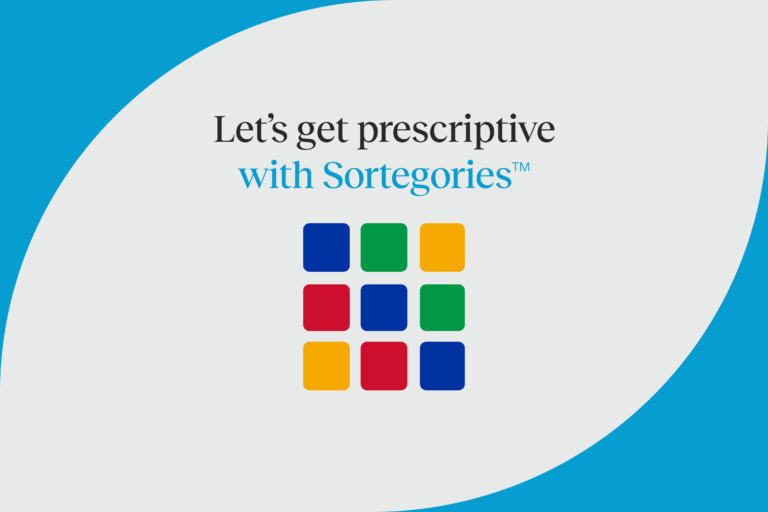Mastering phoneme segmentation
Phoneme segmentation, a core component of the phonemic awareness continuum, is the ability to break words down into individual sounds, or phonemes. The ability to segment phonemes is essential for reading and writing development, and the mastery of phonemic awareness is a strong predictor of reading success.

What are phonemes?
A phoneme is the smallest unit of sound that when combined with other phonemes, creates a word with a specific meaning. For example, the word cat is the combination of three different phonemes: /k/ /a/ /t/. Changing one phoneme in that combination will create a new word with an entirely different meaning, such as /b/ /a/ /t/ (bat).
Although there are 26 letters in the English language, there are 44 different phonemes.
This video demonstrates the 44 different phonemes.
There are more phonemes than letters because there are several letters in the alphabet that represent different sounds depending on the spelling pattern.
It is important to think of phonemes as the sound of speech that can be represented with letters, or groups of letters (called graphemes), rather than the sounds that letters make.
Phonemes serve as the building blocks for words, and the ability to discern and manipulate them is fundamental for literacy development. Being able to hear and identify individual sounds in words helps learners develop their reading and writing skills. Phonemic awareness allows students to blend sounds together to be able to read, and the segmentation supports writing by helping students to hear the individual sounds that are then used to encode (write) the words they hear.
Phonemes vs graphemes
Where phonemes are the smallest units of sound in a language, graphemes are the individual letters or groups of letters that combine to represent a single sound. In the English language, several phonemes can have multiple grapheme representations.
The table below illustrates the difference between phonemes and graphemes.
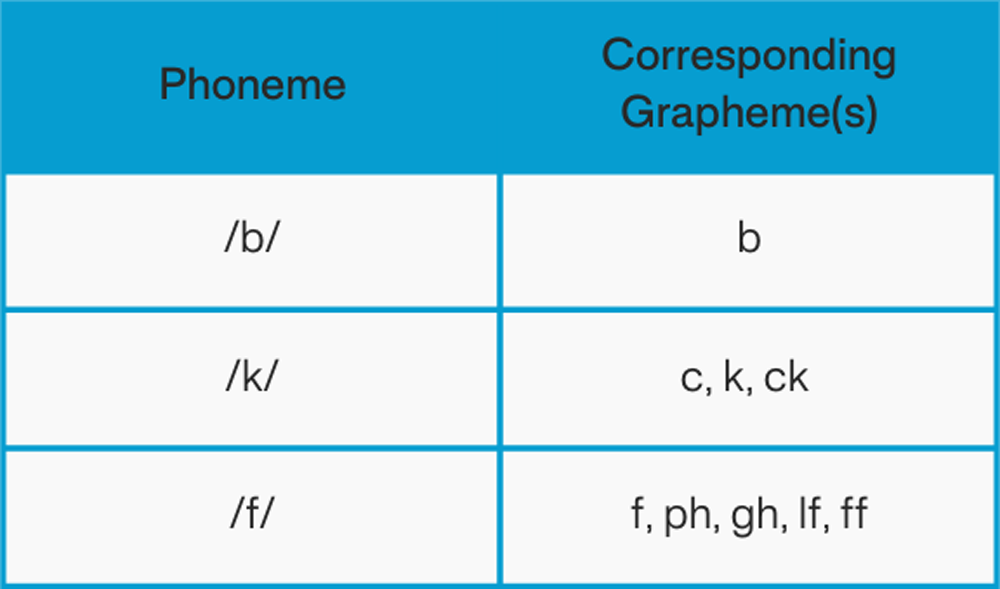
Phonemes play a crucial role in spoken language, influencing pronunciation and distinguishing between words, while graphemes are fundamental to the written language. They are the visual symbols that convey the sound a phoneme makes.
Benefits of phoneme segmentation
Mastering phoneme segmentation carries many benefits, specifically with respect to decoding and encoding skills. Decoding is the ability to convert written symbols (graphemes) into speech. By breaking down words into individual phonemes, learners can sound out words and begin to recognize patterns, such as long vowel spelling patterns as found in cake, /k/ /ā/ /k/ (e), which will allow them to build greater automaticity leading to increased reading fluency.3
Similarly, encoding is the translation of spoken language to graphemes. When learners can identify and manipulate individual phonemes, they have the building blocks for spelling and writing skills.
The ability to segment and blend phonemes supports the development of decoding; when students decode with accuracy and automaticity, they develop reading fluency, laying the groundwork for literary success. Phoneme segmentation and blending are also critical to spelling and writing. Finally, phoneme segmentation instruction can support struggling readers, which will be examined in more detail below.
Segmentation strategies
There are several practical and engaging strategies teachers can employ in the classroom to support the development of phoneme segmentation.
Explicit instruction on phoneme segmentation starts with simple examples such as cat or dog. Teachers will highlight the distinct sounds within each word (k/ /a/ /t/ or /d/ /o/ /g/). Combining explicit instruction with a multisensory approach, such as finger tapping, will support learners in identifying the individual sounds they hear within each word. For instance, cat can be tapped out using the pointer finger of the right hand against the thumb for /k/, then the middle finger against the thumb for /a/, and the ring finger against the thumb for /t/.
Incorporating visual aids will further support the development and understanding of phoneme segmentation. 95 Percent Group utilizes a “Sound-Spelling Mapping Routine,” either with or without chips, to support phoneme awareness and connecting phonemes to graphemes.
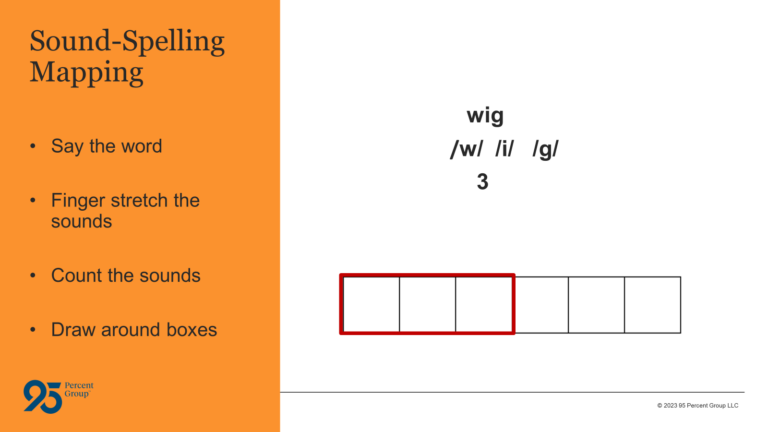
For example, for the word “wig,” students would do the following:
- Say the word
- Finger stretch (or tap) the sounds
- Count the sounds
- Draw around the boxes
- Pull down one sound at a time
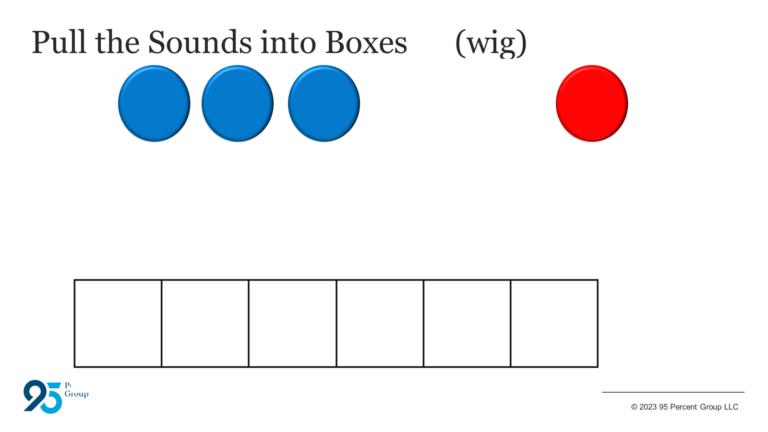
- Write the letters below each box
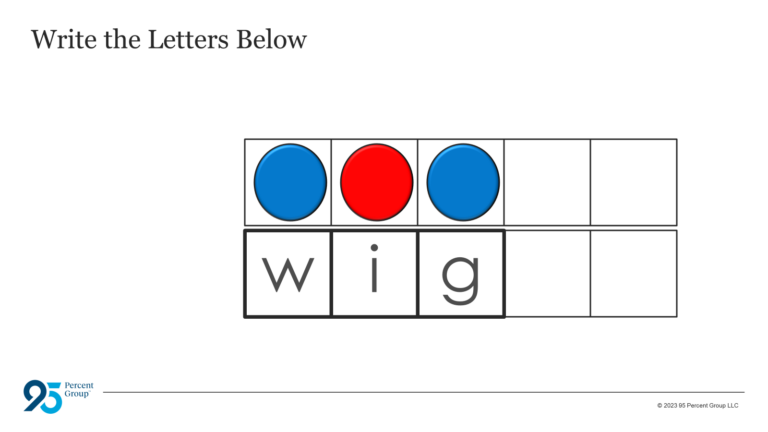
- Say the word
The use of manipulatives or movement engages the students further by making the lesson more interactive.
95 Percent Group provides additional games and strategies that can be used to teach phoneme segmentation and phonemic awareness.
Phoneme blending
A student’s ability to identify and isolate the sounds inside of a word is a critical skill in reading readiness. Equally as important is the ability to look at a series of sounds (/k/ /a/ /t/) and blend them together. The first step to doing this might be to elongate each sound as you say it, drawing it out until it “blends” into the next sound. At first, children will need to do this work out loud. Eventually, we help them understand that the blending of sounds happens in your head and, with practice, becomes automatic.
Differentiation and assessment in phoneme awareness instruction
Differentiating instruction based on individual needs and of students is crucial for creating an inclusive and effective learning environment. Recognizing and addressing each learner’s unique strengths and challenges enhances engagement, facilitates deeper understanding, and promotes overall academic success.
Throughout explicit instruction and group work, teachers will regularly observe students to gauge their level of engagement, participation, and comprehension. Using a formal assessment tool, teachers can implement structured observations using checklists to identify specific areas of progress and achievement, as well as students who would benefit from implementing intervention strategies.
Phoneme segmentation in action
Phoneme segmentation can easily be integrated into classroom activities, often incorporating multisensory instruction, which will engage the students and encourage a deeper understanding of the concepts.
In 95 Percent Group’s Phonemic Awareness Suite™, educators will find a number of activities designed to meet students where they are and help teachers prepare them for the next steps in literacy acquisition.
Some of the components include:
- Core: 95 Pocket PA: the powerful, portable phonemic awareness solution for K-1 readers.
- Phonemic Awareness Screener for Intervention™: allows educators to easily pinpoint skill deficits and personalize instruction for each child
- Phonemic Awareness Intervention Resource for Educators: a go-to source for classroom-ready lessons on alphabetic and phonemic awareness, specially designed for intervention groups.
Conclusion
Phoneme segmentation, a core component of phonemic awareness, involves breaking words into individual sounds, or phonemes, forming the foundation for reading and writing. Phonemes and graphemes differ in that graphemes are the letters or groups of letters that spell the phoneme. Mastering phoneme segmentation is crucial for decoding and encoding skills, leading to reading fluency and improved comprehension, in addition to spelling and writing.
Practical classroom strategies encompass explicit instruction and multisensory approaches, employing routines like Sound-Spelling Mapping. Differentiation based on students’ needs is essential and made possible with ongoing assessments that can guide interventions. Integrating phoneme segmentation into activities like scavenger hunts and storybook hunts, fosters engagement.
Advanced applications extend to morphology, etymology, and phonological interventions, providing profound linguistic insights. Phoneme segmentation serves as a scaffold for language development, supporting essential skills foundational to reading and writing, ensuring learners are equipped for advanced literacy development in later years.
Sources
- “Building Phonemic Awareness with Phoneme Isolation.” ReadWriteThink.org. December 19, 2023. https://www.readwritethink.org/classroom-resources/lesson-plans/building-phonemic-awareness
- “Evidence-based Practices for Teaching Phonological and Phonemic Awareness.” 2019. Regional Educational Laboratory. December 20, 2023. https://ies.ed.gov/ncee/rel/regions/appalachia/blogs/pdf/CoachingMemo_508.pdf
- “Explicit Intervention in Phonemic Awareness.” ALL Ohio Literacy. December 19, 2023. https://allohioliteracy.org/learning-modules/decision-rules-flowchart-interventions/explicit-intervention-phonemic-awareness/.
- Kilpatrick, D.A. (2015). Essentials of assessing, preventing, and overcoming reading difficulties. Hoboken, NJ: John Wiley & Sons, Inc.
- “Phonemic awareness and phonics for reading and spelling.” 2017. Government of Western Australia Department of Education. December 19, 2023. https://myresources.education.wa.edu.au/docs/default-source/resources/phonics/pdlp1001.pdf?sfvrsn=28e48d7f_3.
- “Word morphology.” 2020. Victoria State Government Department of Education. December 19, 2023. https://www.education.vic.gov.au/school/teachers/teachingresources/discipline/english/literacy/readingviewing/Pages/litfocuswordmorph.aspx


